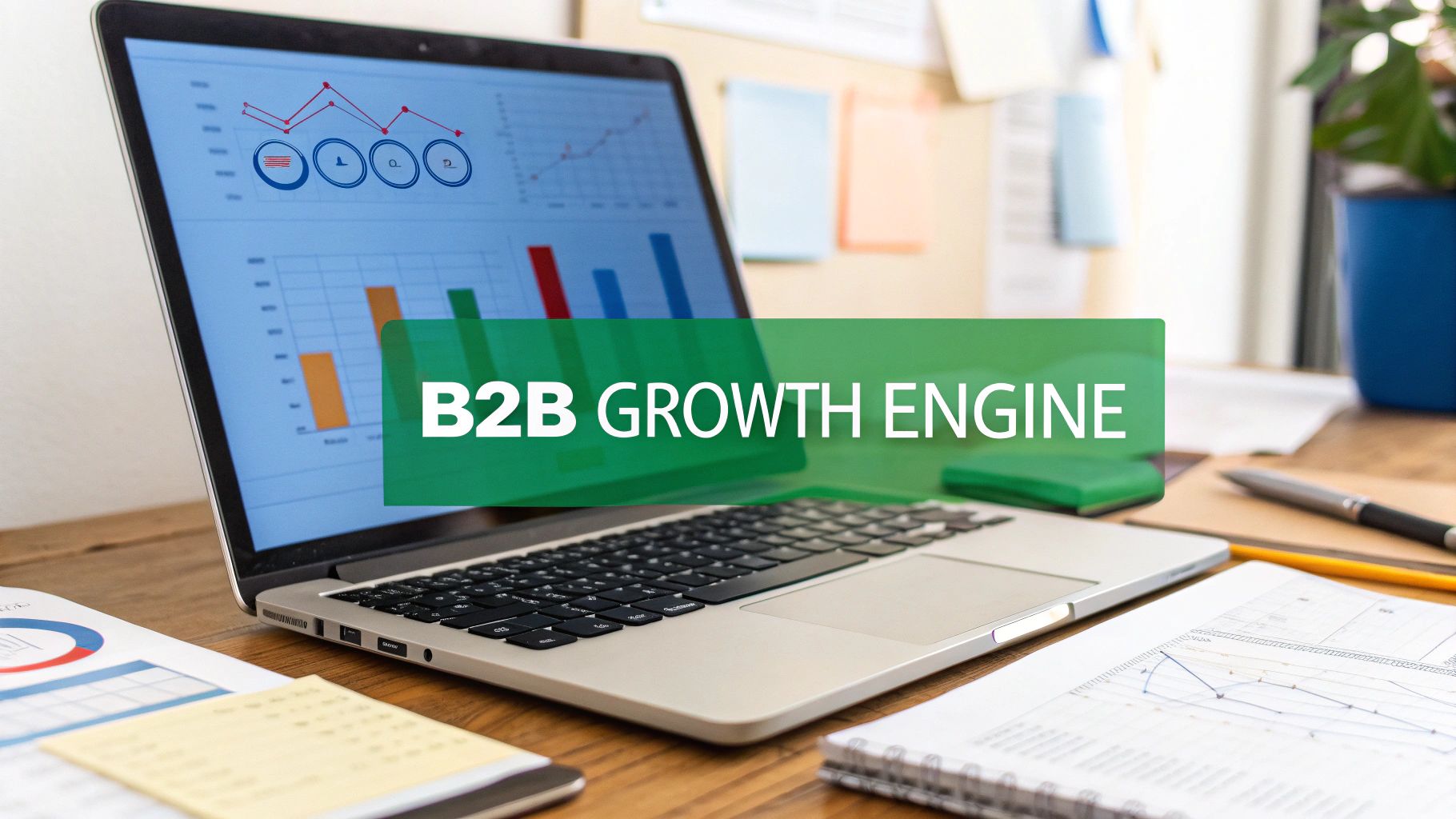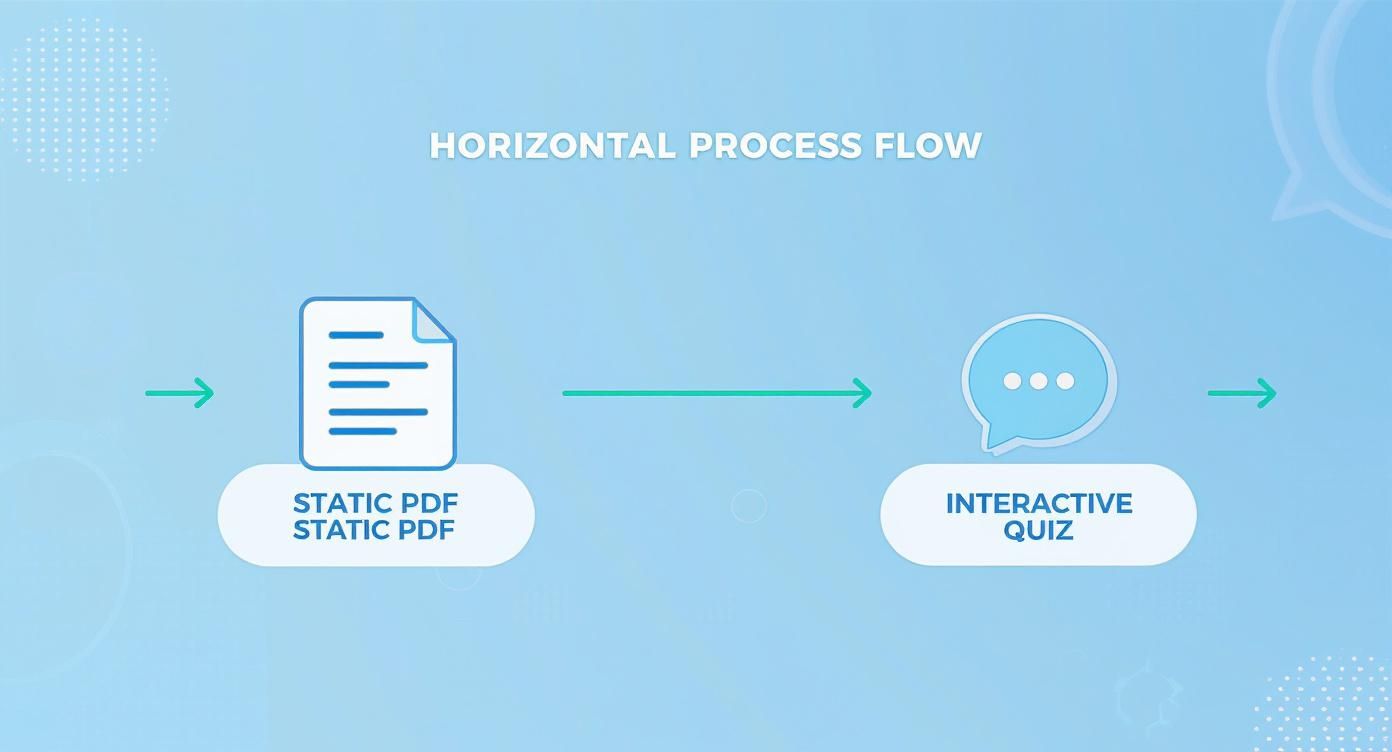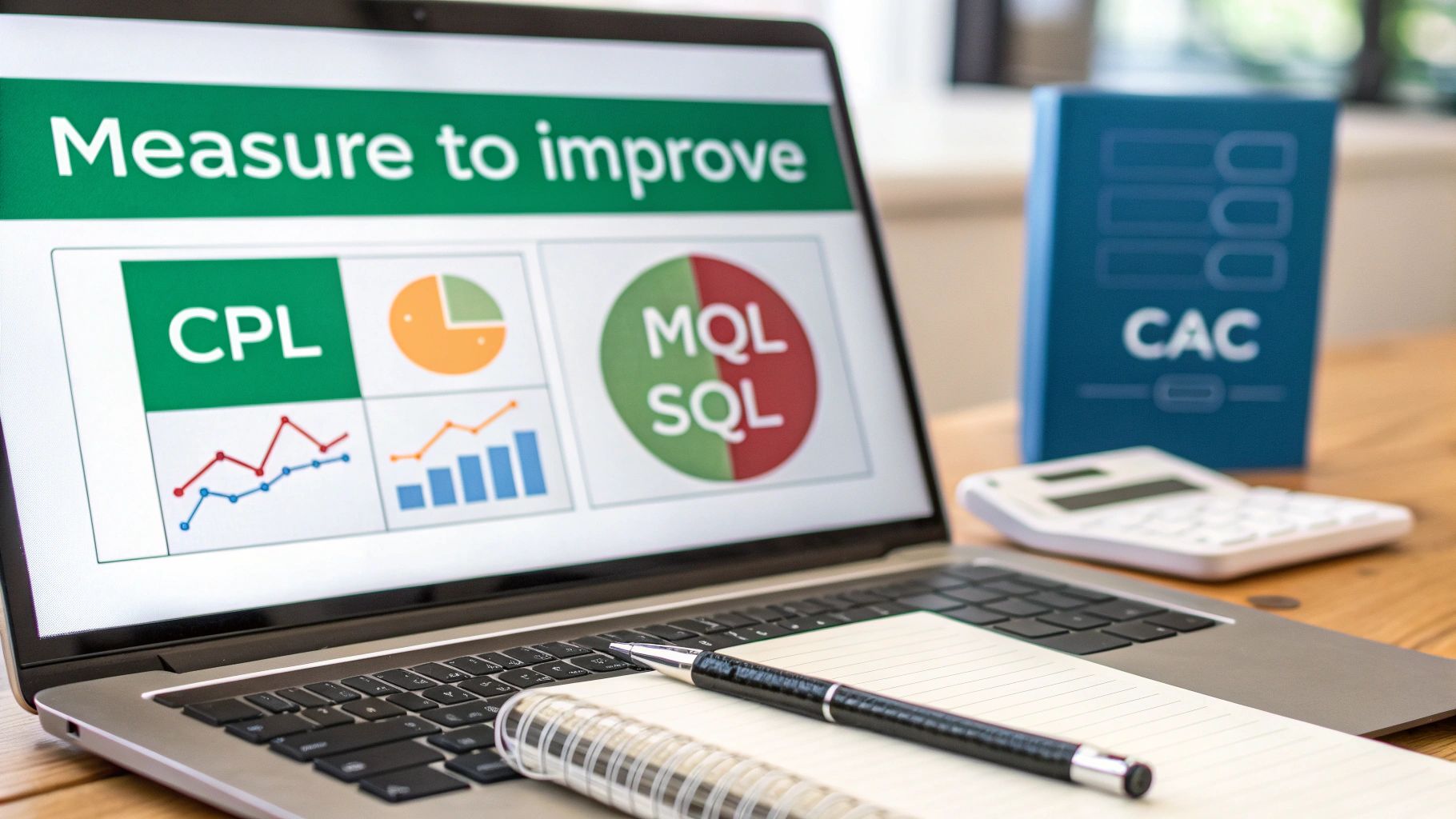The No-BS Guide to B2B Lead Generation That Actually Works
Here are proven strategies for lead generation in b2b with a modern, interactive playbook that attracts, engages, and converts high-quality leads.

Yup, most "lead generation in b2b" advice is broken. It’s not just about collecting names and email addresses. It’s about finding the right potential business customers, sparking a genuine interest, and guiding them along until they’re actually excited to talk to your sales team. A winning strategy doesn't just fill a database; it builds a reliable system for delivering a steady stream of qualified leads—people who have a painful problem you are uniquely positioned to solve.
Why Your Current B2B Lead Generation Fails
It's always the same ... you pour weeks of effort into creating the "ultimate guide" or a painstakingly researched whitepaper. You hide it behind a form, throw some ad budget at it, and cross your fingers.
But the magic never happens. What you get is a frustrating, expensive cycle of high effort for pathetic returns. The form submissions trickle in, filled with bogus emails, students doing research, or people who download your content and vanish into the digital void. It feels like shouting into a hurricane. You know your audience is out there, but you’re just not connecting in a way that starts a real conversation.
The Problem with Passive Content
The root of the problem is the static content itself. Think about it: a downloadable PDF is a monologue. It asks a prospect for their valuable contact information in exchange for something they'll get... eventually. There's no instant gratification, no personal touch, and zero real engagement. It’s a transaction, not a conversation.
Volume isn't the problem; it’s actually about connection, and that’s where static content consistently falls flat. Your ideal customers are swamped. They aren’t looking for another document to clog up their "to read" folder. They’re hunting for immediate answers and solutions to the problems staring them in the face right now.
Your lead magnet shouldn't feel like a transaction. It should feel like the beginning of a helpful conversation where you provide immediate, tangible value. That's a bar a static PDF can rarely clear.
A Blueprint for What Actually Works
This guide is about ditching that outdated advice. We're going to lay out a blueprint for a B2B lead generation engine that truly works—one that feels less like marketing and more like building something genuinely useful for your audience.
We’ll break down how to shift from passive content consumption to active, value-first engagement. This means swapping out those dusty PDFs for simple, interactive tools that solve a real problem for your visitor on the spot. Imagine offering a calculator that instantly spits out their potential ROI, or a quick assessment that helps diagnose a specific pain point.

These kinds of tools don't just capture a lead; they qualify them through the very act of using them. This approach draws in prospects who aren't just browsing—they're actively trying to solve a problem and are far more prepared for a meaningful conversation with your team.
Swap Static PDFs for Interactive Experiences
The traditional B2B lead magnet—that gated PDF, the exhaustive whitepaper, the 50-page eBook—is fundamentally broken. It’s a one-way street. You ask for a prospect's valuable contact details in exchange for a generic reward they might get around to reading… eventually. It forces them to do all the work with no immediate payoff.
Think about that user experience. A prospect lands on your page, fills out a form, checks their email, clicks a download link, and finally gets a document. It's a process loaded with friction and offers zero instant gratification. This is a transaction, not an interaction, and it’s why so many of those leads feel lukewarm at best.
The Power of Instant, Personalised Value
Now, contrast that outdated model with an interactive tool. Instead of offering a guide on "How to Calculate Marketing ROI," what if you offered a simple calculator? A prospect could plug in their own numbers and see their potential ROI in seconds. The value is immediate, personal, and directly tied to their specific situation.
They aren't just downloading a document; they are actively solving a piece of their own problem, right there on your website. This is the core psychological shift that makes interactive content so powerful for lead generation in b2b. You're not just giving them information—you're giving them an experience and a result.
The moment a prospect receives a personalised insight from one of your tools, they stop seeing you as just another vendor. They see you as a helpful expert who understands their world.
This two-way conversation delivers a tailored experience that a static PDF could never hope to match. You move from being a gatekeeper of information to an active partner in their discovery process. To explore this further, our guide on adding interactivity on websites explains exactly how these dynamic elements can transform user engagement.
Simple Tools Create Powerful Conversations
I know what you might be thinking: "Building a calculator sounds complicated and expensive." That’s a common misconception. You don’t need a team of developers to get started. Many no-code platforms let you build surprisingly effective tools—quizzes, assessments, diagnostics—in a single afternoon. I’ve seen simple, single-purpose tools built over a weekend generate more high-quality leads than a content team could produce in a quarter.
The magic here is that these tools do the initial qualification for you. Someone who takes the time to use a "Sales Funnel Health Assessment" is telling you exactly where their pain points are. They are self-segmenting and providing you with rich, zero-party data that is infinitely more valuable than just a name and an email address.
To really see the difference, let’s put the two approaches side-by-side.
Static vs Interactive Lead Magnets: A Head-to-Head Comparison
The gap between a passive download and an active experience is massive. One is a monologue; the other is a conversation. Here's how they stack up.
| Attribute | Static Lead Magnet (e.g., PDF, eBook) | Interactive Lead Magnet (e.g., Calculator, Quiz) |
|---|---|---|
| Value Delivery | Delayed and generic; requires the user to find their own answers. | Instant and personalised; provides an immediate, tailored result. |
| User Engagement | Passive consumption; a one-way information push. | Active participation; a two-way, value-driven conversation. |
| Data Quality | Basic contact information (name, email), often unreliable. | Rich, zero-party data (pain points, needs, budget), highly accurate. |
| Lead Qualification | Minimal; a download indicates only topical interest. | High; usage signals strong intent and self-identifies a problem. |
| Conversion Psychology | Transactional; "Give me your email for this document." | Relational; "Let me help you solve your problem right now." |
If your current lead magnets feel like they're underperforming, the problem might not be the topic or the promotion—it could just be the format itself. Before you spend another month creating a new eBook, ask yourself if a simple interactive tool could solve the same problem for your audience, only faster and with a far better experience.
It’s about building something genuinely useful, not just another piece of content.
Mapping Your Full-Funnel B2B Lead Strategy
Solid lead generation in b2b isn’t a one-off campaign; it's a complete journey you map out for your future customers. Far too many businesses just throw a bunch of tactics at the wall to see what sticks. A truly modern strategy, however, means designing a seamless path from the first moment someone hears about you all the way to a signed contract.
When you start thinking this way, you stop scrambling for individual leads and begin building a reliable engine for growth. Every piece of content, every ad, and every email has a specific job to do, all designed to meet your prospect exactly where they are in their buying process. Here's a look at what that means at each stage.
Top of Funnel (ToFu): Building Awareness
Right at the top of the funnel (ToFu), your prospect probably isn't searching for your product. In fact, they might not even realise the full extent of the problem you solve. Your mission here is simple: build awareness and educate.
This is your chance to answer the big, problem-related questions your ideal customers are typing into Google. We're talking about genuinely helpful, ungated blog posts, insightful social media updates, and high-level industry reports. The goal is to provide real value with no strings attached, establishing your brand as a trusted expert long before you ever ask for their details.
- Problem-Focused Blog Posts: Write articles that dig into your audience's core pain points, not your product features. For example, instead of a post titled "Our Software's Key Features," you'd write something like, "5 Telltale Signs Your Current Workflow Is Costing You Money."
- Social Media Content: Share quick tips, interesting stats, and thought-provoking questions on platforms like LinkedIn. The aim is to start conversations and pull people back to your more in-depth educational content.
Middle of Funnel (MoFu): Educating and Qualifying
Once a prospect understands their problem, they slip into the middle of the funnel (MoFu). Now they’re actively researching solutions, and this is your golden opportunity to stand out from the noise. It’s the perfect moment to swap out that generic PDF download for an interactive tool.
Think about it: a static guide forces your prospect to do all the work, sifting through information to find what’s relevant. But an interactive calculator or a diagnostic assessment gives them a personalised, instant result. This is a complete game-changer. They aren't just passively reading; they're actively engaging with a tool that helps them understand their own situation on a deeper level. For more ideas on building out your acquisition plan, have a look at these powerful B2B Lead Generation Strategies to support your funnel.
The middle of the funnel is your transition point from being a general educator to a specific problem-solver. An interactive tool doesn't just tell them you can help—it proves it by delivering immediate, tangible value.
This infographic really highlights the shift in engagement you get when moving from a static PDF to a more dynamic quiz.

You can see how interactive experiences foster a genuine two-way dialogue, pulling prospects in rather than just pushing information at them.
Bottom of Funnel (BoFu): Converting High-Intent Leads
Finally, we have the bottom of the funnel (BoFu). Prospects here are solution-aware and ready to make a call. They’ve done their homework and are now weighing up their options. Your job is to make it crystal clear why you’re the best choice.
At this stage, your content needs to be highly specific and focused on your product or service. This is the place for demos, personalised consultations, and detailed case studies that back up your claims with hard evidence and real-world results.
And here’s the best part: because you used interactive tools in the MoFu stage, you’re not going in blind. The data you collected gives you incredible insight into their specific needs and challenges, allowing you to tailor your demo or consultation perfectly to their situation. This creates a smooth, highly relevant sales experience and ensures your sales team invests their valuable time only with prospects who are truly a good fit. To see how all these stages connect, you can learn more about structuring a complete B2B sales funnel.
100% Free Lead Magnet Audit
Our AI analyzes your website and delivers custom growth strategies in seconds.
Tapping into Events for High-Value B2B Leads
In a world filled with endless digital noise, actually showing up in person—or live on screen—has become a genuine superpower for B2B lead generation. I’m going to say something that might sound controversial: if you think events are just about scanning badges and collecting a fishbowl of business cards, you're leaving a mountain of revenue on the table. Events aren't just a line item in your marketing budget; they are one of the few channels left for direct, human connection that digital simply can't replicate.
The biggest mistake I see companies make is treating events as a passive activity. They book a booth, put up a banner, and then just wait for people to wander over. This "build it and they will come" mindset is exactly why so many teams come home with a stack of low-quality leads and a hefty dose of disappointment. The secret isn't just being present; it's about engineering meaningful engagement before, during, and after the event.
Modern Strategies for Maximising Event ROI
Let's reframe the goal from mere attendance to active participation. A truly successful event strategy is a three-act play that can turn a standard trade show or webinar into a pipeline-building machine. It requires a modern approach that blends old-school handshakes with smart, interactive technology.
Here’s a simple way to structure it:
- Pre-Event Outreach: The real work starts weeks before the doors open. Your primary goal should be to fill your calendar with pre-booked meetings. Scour the attendee list, use LinkedIn to find ideal prospects who have announced they're going, and send out genuinely personalised invitations for a quick coffee or a one-on-one demo at your booth.
- During-Event Engagement: Please, ditch the static brochures and the sad bowl of mints. Your booth needs to be an experience. Instead of a passive sales pitch, what if you offered a live, interactive diagnostic tool? Imagine a prospect answering a few quick questions on a tablet and instantly seeing a personalised report about their business challenges. This creates genuine buzz and, more importantly, ensures you're capturing qualified leads who are actively looking for solutions.
- Post-Event Nurturing: This is where the vast majority of companies drop the ball. A prompt, personalised follow-up is absolutely critical. Don't just send a generic "great to meet you" email. Reference the specific conversation you had or the results from the interactive tool they used at your booth. From there, enrol them in a specific nurture sequence that directly addresses the pain points they shared. This is how you turn a fleeting conversation into a real sales opportunity.
Turning Webinars from Monologues into Dialogues
These same principles apply just as much to digital events. A webinar should never feel like a university lecture where one person drones on for an hour. That's a surefire way to have your audience multitasking, checking their emails, or just dropping off entirely.
The magic of a great webinar isn’t found in the slide deck; it’s in the dialogue you create with your audience. You want them leaning in, not zoning out.
This is where simple interactive elements can make all the difference. You can easily incorporate live polls to gauge audience opinion, run Q&A sessions throughout the presentation instead of saving them for the end, and even use breakout rooms for smaller, more focused group discussions.
Every single interaction point is another opportunity to gather data, truly understand your audience’s needs, and identify those high-quality, conversation-ready leads who are actively engaged with your message. The goal is to make every single attendee feel seen and heard.
How to Measure and Optimise Your Lead Generation Engine
You can build the most creative and engaging B2B lead generation engine in the world, but if you can't measure it, you can't improve it. That’s a hard truth, but it’s what separates the teams that consistently hit their numbers from those that are always just guessing.
The real problem? Most marketers are drowning in vanity metrics. Things like downloads, impressions, and website traffic look nice in a report, but they tell you almost nothing about what’s actually driving revenue.
Let's get controversial for a moment: your download count is a dangerously misleading metric. It makes you feel productive, but it doesn't pay the bills. A student doing research and a C-level executive with a budget both count as one "download," yet they represent wildly different values to your business. We have to stop celebrating sheer volume and start obsessing over quality and conversion velocity.
This means shifting your focus to the numbers that truly matter. These are the Key Performance Indicators (KPIs) that connect your marketing efforts directly to sales outcomes, giving you a clear, honest picture of your engine's health.

The KPIs That Actually Drive Revenue
If you only have time to track a handful of metrics, make them these. They cut through all the noise and give you an unfiltered view of your performance.
Cost Per Lead (CPL): This is your basic efficiency metric. It tells you exactly how much you're spending to get a single name and email into your system. While it's a good starting point, CPL is pretty meaningless without the context from the other KPIs.
MQL to SQL Conversion Rate: Now we're talking. This is the big one. It measures the percentage of marketing-qualified leads that your sales team actually accepts as sales-qualified. A low rate here is a massive red flag, pointing to a serious misalignment between what marketing is delivering and what sales truly needs.
Customer Acquisition Cost (CAC): This is the ultimate bottom-line metric. It rolls up all your sales and marketing costs—salaries, ad spend, software—and divides that total by the number of new customers you won in a period. Your entire goal is to drive this number down over time.
These metrics give you a proper framework for making smarter decisions. You can start asking much better questions, like, "Which channels produce leads with the highest MQL-to-SQL rate?" instead of just, "Which channels give us the most downloads?"
From Basic Data to Precision Targeting
This is where interactive content gives you an almost unfair advantage. A static PDF gives you a name and an email. An interactive calculator or an assessment, on the other hand, provides a treasure trove of rich, first-party data you can use for incredibly accurate lead scoring and segmentation.
Think about it. When someone uses your "ROI Calculator," they're not just another lead. You now know their company size, their current spending, and their biggest financial pain points—all information they volunteered themselves. This data allows you to score leads with a level of precision that is simply impossible with passive content.
You're no longer guessing at a lead's intent; they are explicitly telling you what their problems are through their actions. This transforms your follow-up from a cold pitch into a highly relevant, helpful conversation.
If you’re not sure how your current lead magnets are performing, getting an objective baseline can be a game-changer. I built a free tool called the lead magnet audit on Magnethive to do just that. It generates a comprehensive report with AI-powered lead magnet ideas, analyzes your current lead magnet, and even shows the potential ROI impact of making improvements. It gives you a clear, data-backed path forward.
Ultimately, to keep improving your lead generation engine, you have to measure the effectiveness of your digital presence. Discovering the best practices for SEO performance monitoring ensures your B2B content actually reaches and converts potential leads. By connecting on-site engagement data with your traffic sources, you can build a powerful feedback loop for continuous improvement.
Frequently Asked Questions About B2B Lead Generation
Getting into B2B lead generation can feel like you're trying to solve a puzzle with constantly changing pieces. New tools and tactics pop up all the time, and it’s tough to know where to put your energy and budget for the best return. This section tackles the most common questions I hear from fellow marketers and founders.
My goal here is to cut through the noise. No fluff, just straight-up advice based on what actually works in the real world.
What Is the Most Effective B2B Lead Generation Channel?
Let's get one thing straight: there's no magic bullet. I see so many people chasing the latest trend, but the reality is, what works depends entirely on your industry, who you're selling to, and what you're selling. A strategy that crushes it for a SaaS company could be a complete dud for an industrial parts supplier.
The most successful, long-lasting strategies I’ve ever built always use a mix of channels. Think of it like a sturdy table—it needs more than one leg to stay upright.
- Organic Search (SEO): This is the long game. It can take 6-12 months to really see traction, but the payoff is a steady stream of highly qualified, low-cost leads. When someone finds you through search, they’re already looking for a solution like yours.
- Targeted Paid Ads: Platforms like LinkedIn give you immediate access to your ideal audience. It’s perfect for testing new offers and getting leads in the door quickly, but your Cost Per Lead (CPL) will naturally be higher. It’s the accelerator, not the whole engine.
- Interactive Content: This is the secret sauce that makes everything else perform better. A simple calculator or an assessment promoted through both SEO and paid ads can blow a static eBook out of the water.
The real win isn’t about finding one perfect channel. It’s about creating a system where you test, measure, and discover the combination of channels that brings in the highest quality leads for your business—not just the highest number.
How Can I Improve the Quality of My B2B Leads?
This is the big one, isn't it? The question that keeps us up at night. The solution is actually pretty simple, but it requires a change in thinking. If you want better leads, you have to stop using passive, low-effort content as bait. A generic PDF download signals very little buying intent.
The single most powerful way to boost lead quality is to offer an interactive tool. Just think about the difference in what you learn about the prospect:
- Low-Quality Signal: Someone downloads "The Ultimate Guide to Financial Planning." Are they a student doing research? A competitor? A serious buyer? You have no clue.
- High-Quality Signal: Someone uses your "Retirement Savings Calculator" and enters their actual age, income, and savings goals.
That person didn't just show vague interest; they actively engaged with their problem and handed you a goldmine of zero-party data. This kind of self-qualification naturally weeds out the tyre-kickers. The data you get is so much richer, allowing you to score leads based on real needs and ensuring your sales team only talks to people who are genuinely a good fit.
How Long Does It Take to See Results?
This is always an "it depends" answer, but the timeline is directly connected to the channels you’re using. There’s no universal waiting period, but you can definitely expect different rhythms from different tactics.
Paid advertising on platforms like Google or LinkedIn can start bringing in leads within days of launching a campaign. It's the fastest way to get feedback and see activity, but it demands a consistent budget to keep the tap on.
On the flip side, content marketing and SEO are all about the long-term investment. Building organic authority is a slow burn, often taking six months to a year before you see a significant, predictable flow of leads. Once that engine is running, though, it’s an incredibly efficient and powerful asset.
Interactive lead magnets are a great way to bridge that gap. I’ve launched a new calculator, put a modest ad budget behind it, and seen a steady stream of qualified leads within the first month. They give prospects that instant hit of value that makes them act now, giving you quick wins while your long-term SEO strategy matures. It's the perfect way to build early momentum.